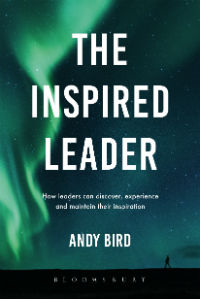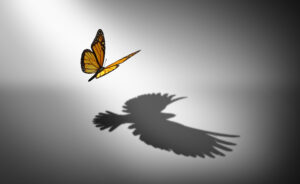Being inspired can be a magnificent, invigorating feeling. But it’s also one that we know surprisingly little about. Does it happen by chance? Are all forms of inspiration the same? Can we influence how and when we feel inspired? In his new book, The Inspired Leader, Andy Bird asks some searching questions around this for leaders in business. We talked to him about how inspiration is experienced by people in positions of leadership, how they maintain it over time and how individuals have to discover the inspiration they need for themselves in order to succeed in inspiring others.
Why did you write The Inspired Leader?
People in leadership roles in all walks of life are under enormous pressure these days. There is tremendous responsibility and intensity around deliverables, and in some roles a lot of public scrutiny as well. And within that context there is also a huge emphasis on the need to inspire other people. There is so little attention given to how leaders find the inspiration they need for themselves, though. What I really wanted to do was find out how leaders maintain their spirit and where they get their motivation from – and ground that in the experiences of people from all walks of life. And I wanted to take a look at the mind sets and behaviours around inspiration that other people could then benefit from in order to find these states for themselves more often.
How do you define the feeling of inspiration?
I have noticed that people love being inspired, and on the leadership programmes that I have run there is always huge thirst for it. At one level, that is a fundamental human trait – that feeling of having our spirits lifted, letting our life force flow and seeing the possibilities of the world. And I think at a general level that’s what inspiration means.
Here, though, I’ve tightened the definition, because this is specifically about leadership inspiration. While researching the book, I spoke to Claire Chiang, who founded the Banyan Tree hotel chain, to discover where she gets her motivation from. She had a wonderful phrase that encapsulates it well for me, which is that she seeks to ‘maximise and multiply’ herself.
Seeing opportunities to grow, for me, is the ‘maximise’ bit. The ‘multiplying’ is the interesting bit about leadership – if you make the most of yourself, then there is also the desire to increase that beyond yourself; to make a difference and have a positive impact on the world.
How can we foster conditions in our own lives to be inspired?
We all get inspired now and again – but does it happen by chance? I would argue you can’t choose the specific moment when you might feel inspired, but what I think is exciting is that you can increase and improve the conditions that will help you feel inspired. There are things you can do that significantly increase your chances of experiencing it more deeply and more regularly.
In inspiration, an interaction takes place between three things: the first are the triggers we experience around us; the people we meet and the events we experience. An important source of inspiration for leaders also tends to be challenging situations, for example. And one way to approach this is to expose yourself to those triggers more often.
The second element is our mindset; if we engage with the world in the spirit of openness and curiosity and look to learn rather than to judge, we are far more likely to see the positive in things – and the triggers to inspiration are much more likely to have an impact on us.
The third thing is what we care about and believe in: our deepest motivations. It’s fundamental to understand oneself better and to get a clearer view of what your values and passions are, and what you love doing to be inspired.
I’ve interviewed a lot of people and when I say I’m going to talk to them about inspiration, their immediate assumption is that I’m going to talk to them about inspiring others. They often say, “I don’t see myself as a particularly inspiring person”. So I’ve found that it’s more productive to say, “I’ve come to talk to you about what inspires you.” That then sets off another kind of conversation, where they think about the things they love and value and they tell their stories – and I then sit there thinking, “this is so inspiring!”
I believe that everyone has the possibility and potential to inspire others, but they can’t do that unless they’ve discovered the way in which they can inspire themselves. If you can become inspired, it’s so much easier to bring that energy and enthusiasm to other people. So the first thing to do is to focus on yourself – which is not necessarily the natural place you’d think to start.
You talk about the relationship of time to inspiration in the book. What role does it play?
There is something interesting about the importance of time and our relationship with it with regard to inspiration. We’ve only got a certain amount of time, and if you’re going to maximise and multiply yourself you have a time frame in which to do it.
We can look back at everything we’ve done and forward to everything there is to come and then there’s this moment right now – the present that we are experiencing. We tend to be inspired by things we see in the future; leaders are inspired when they have a sense of purpose and vision that leads toward something. The second form of inspiration is the past and the things we’ve already achieved. These can make you proud and believe you’re capable of doing more – which then sends you into the future again.
So if there is something in the past and something in the future, it begs the question: what about the present? And another really important source of inspiration is thoroughly loving and being absorbed in what you’re doing in the moment. There’s a psychological concept around this called flow – or being in a flow state. And basically it means doing things you enjoy and that challenge you in the moment.
There is a final path to inspiration, too, that is almost beyond time, and is perhaps the purest, most distilled form of inspiration. This is when you have those moments when you see what really matters and get an opportunity to see the world a little bit differently. It’s a moment of illumination and what matters in life if we really want to maximise ourselves. There is a wonderful story in the book involving Nelson Mandela, and his generosity and humility that illustrates this beautifully.
The core of inspiration, though, is to really work out what you love doing, what you are good at and what you believe in. If you’re going to be a great leader, you need to be in touch with those things. You can’t receive the inspirational opportunities in the world around you if you’re not open to them – and that requires a humility that great leaders bring. It’s a challenge, because you’ve got to have self-confidence – but as soon as you get overfull with pride and arrogance you become closed and selfish, and that then means you’re unable to receive so much inspiration – and it also limits your ability to give it to others.
The Inspired Leader by Andy Bird (Bloomsbury, £12.99) is out on November 23rd 2017.






